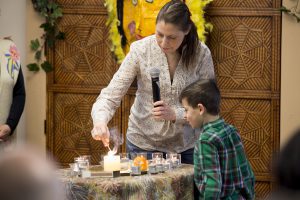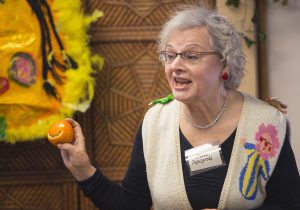Author: Climate Central (2012, Pantheon Books, a division of Random House)
Reviewed by Theresa Forsman
Ideally, science and journalism are non-partisan. Ideally, discussions about global warming are also non-partisan. That makes Global Weirdness an ideal book for those who want to understand the accumulated knowledge about climate change and the risks it poses. The journalists at Climate Central, a nonprofit, apolitical science and journalism organization, provide a straightforward, easy-to-understand tour of this knowledge. The titles of the four sections are a good summary of the book: What the Science Says, What’s Actually Happening, What’s Likely to Happen in the Future and Can We Avoid the Risks of Climate Change?
What the Science Says: Scientists know, through the information in layers of , layers of ocean sediment, and tree rings, that high carbon dioxide levels in the atmosphere equal high global temperatures. Thousands of years ago, when naturally occurring high carbon dioxide levels led to drought, groups of hunter-gatherers moved a few hundred miles to better conditions. For a world population of 7 billion people, dependent on modern farming methods, the power grid, and an economy rooted in cities, moving operations to escape rising sea levels or drought is not so easy. Even thousands of years ago, adjusting to climate change probably involved “levels of mortality that we unaccustomed to today,” the authors point out.
Wait a minute. We had global warming in millennia past due to naturally occurring high levels of carbon dioxide? The planet—and humans—obviously survived, so what’s the worry? The worry is the concentration of today’s carbon dioxide levels and, as mentioned above, the size and circumstances of today’s population. The composition of air bubbles trapped in miles-deep ice near the North Pole shows that for the last 650,000 years, carbon dioxide levels in the atmosphere were never higher than 300 parts per million. Carbon dioxide levels over the last 10,000 years—until very recently—ranged from 260 to 280 parts per million. In 1800, they were at 280. Now, they are at 390, fueled by the coal and oil that fed the Industrial Revolution, which in turn triggered an increase in population from 700 million in 1750 to nearly 7 billion today. No wonder the first decade of this century has been the warmest on record.
If we’re going to discuss climate change, we should know the basic facts: The biggest sources of carbon dioxide in our atmosphere are fossil fuels, deforestation, agriculture (because of commercial fertilizers and the digestive tracts of livestock) and concrete manufacturing (cement is made from carbonate rocks, such as limestone, which contain carbon). Landfills and rice paddies generate large amounts of methane, another heat-trapping gas.
What’s Actually Happening: The authors provide more information for the well-informed global citizen of the 21st Century: the United States emits 19.9 metric tons of carbon dioxide per person per year, more than twice the amount of other industrialized countries and more than seven times the average output among non-developed countries; the sea level is 8 inches higher than in 1990; the continental United States had twice as many record highs during the first decade of the 21st Century as record lows; the ice caps have been shrinking since about 1850 and the rate of shrinkage is accelerating.
Other types of disruptions are occurring: Freshwater is becoming much more scarce as rivers dry up; a longer hatching season means mosquito-borne diseases, including dengue, are becoming more common; carbon dioxide buildup in oceans is affecting the plants and animals that live there—fore example, oysters can’t develop their shells in the highly acidic water now found off the Northwest United States. Another example of the trickle-down effect of global warming is a larger quantity of heat-trapping water vapor, the third-most-abundant gas in the atmosphere after nitrogen and oxygen. Temperature, of course, determines how much water evaporates from bodies of water and the soil.
What’s Likely to Happen: The result of global warming, which the authors agree is a fair synonym for climate change today, is not life as we know it, only hotter. Melting glaciers will affect the direction and flow of rivers. Larger amounts of water evaporating from the oceans will lead to more rain and snow in some places, more drought in others. Warmer oceans will have different currents, which affects weather. The difference in temperature between the Equator and the Poles is what makes the wind blow. As those temperatures change, the direction and force of the wind will change, affecting weather patterns. Does this explain Hurricane Sandy? See the chapter titled Droughts, Torrential Rains, and Other Extreme Weather are Happening More Often than they Used To.
Because global warming sets in motion the changes described above, and more, scientists don’t expect climate change to look the same everywhere, the authors point out. Some places are likely to get a lot more snow in winter, unless it eventually gets too warm for snow. Other places will get less snow in winter but more rain in summer. Some places will get warmer faster; others will get warmer slower. Educated guesses say that Canada, Russia and the northern countries are likely to get more precipitation year-round in this century, parts of North Africa are likely to be drier, the Southwest U.S. may transition to permanent drought, Australia will have drier summers and Atlantic hurricanes will be fewer but more powerful.
Can We Avoid the Risks? Even if we stopped adding carbon dioxide to the atmosphere today, global temperatures would keep rising, Climate Central says, providing a simple analogy: Think of a bathtub faucet and drain. Before the mid-18th Century, the drain could accommodate the trickle of carbon dioxide coming out of the faucet. “The Industrial Revolution opened the bathtub faucet wider, so the carbon dioxide level has risen and it will take a while for the tiny drain to get rid of it. If we simply stopped opening the faucet any wider, the water would still rise. If we turned it down, the water would still continue to rise, just more slowly. And if we turned it back down to the original trickle, which would mean stopping all [human-generated] emissions, the water level would stop rising.” But because the drain is still tiny, it would take a long time for the accumulated water to drain. So, even if we could reduce emissions back to a trickle, the planet would probably be hotter, with altered weather patterns and higher sea levels, for at least a thousand years, they say.
For now, alternative forms of power cannot provide nearly the amount of energy in use today, says Climate Central, which doesn’t propose solutions but raises awareness so that those in charge—and the rest of us—can sort out the facts, the highly educated guesses and the gaping questions on global warming. It seems obvious, at least to this reader, that stopping or slowing global warming has to include a big reduction in the use of coal and oil. If serious conversations about that are taking place, they’re hard to hear over the sound of the wide-open faucet.
Theresa Forsman is a longtime member of the Ethical Culture Society of Bergen County.


